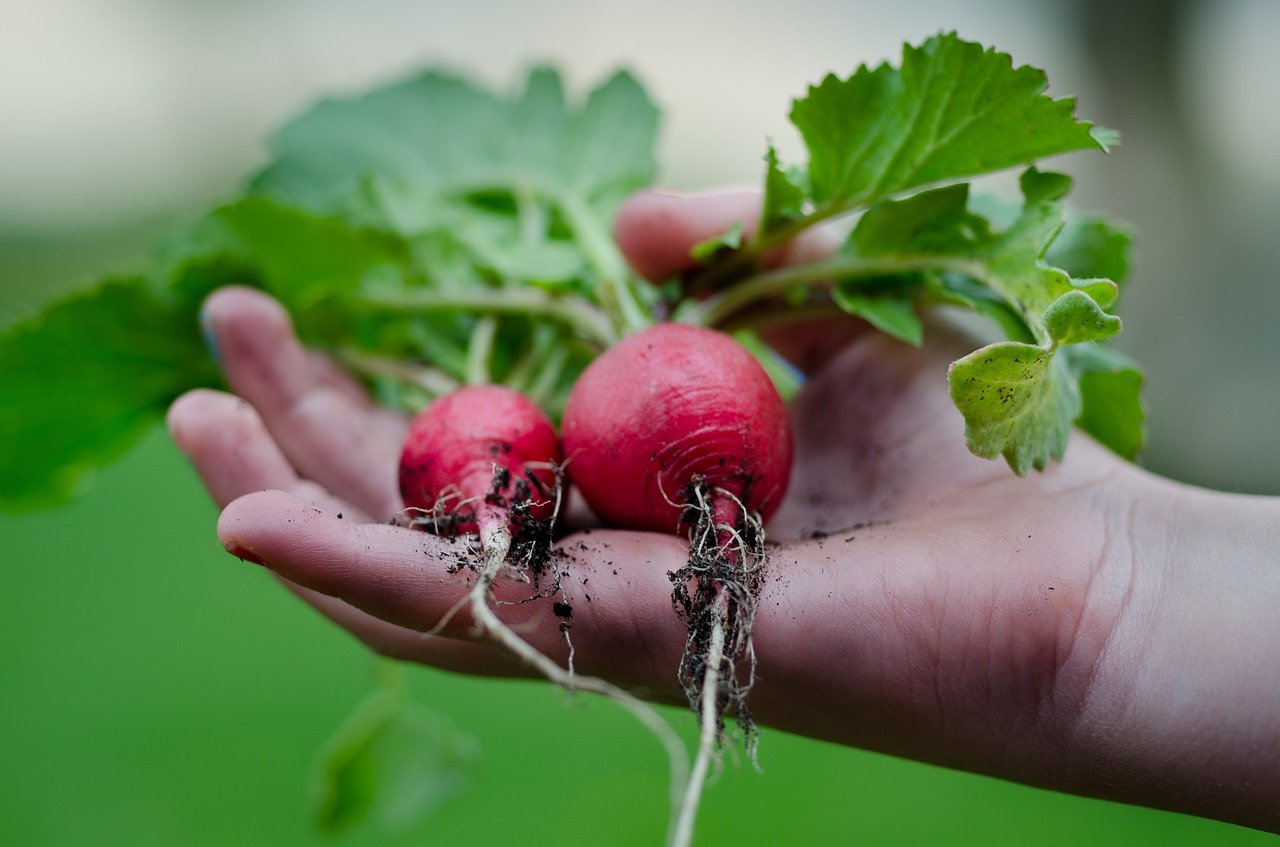
Tips on Balancing the Root Chakra
Today we’ll be starting a new series on chakras. In this series, we’ll be discussing the different chakras of the body as well as the herbs, foods, vegetables, and essential oils that can help each chakra stay balanced. In this month’s post, I’ll be sharing tips on balancing the root chakra, or the base chakra.
What Are “Chakras?”
In the Eastern tradition, and dating back for thousands of years, chakras were known as the energy centers in the body. Each has an element, color, musical note, flower essences, attributions, yoga poses, metals and more associated with it. Chakras are portrayed as spinning wheels along the spine. Each is independent, but they work together holistically in both the physical and spiritual parts of our lives.
In order for us to stay healthy, the chakras must be balanced. Although there are many chakras in the body, this series will concentrate on the seven main ones, starting at the base of the spine and ending at the crown of the head. They are associated with the colors of the rainbow starting with red at the base, orange, yellow, green, blue, purple and white. Some instructions have the last two colors as indigo and purple; it is dependent on from whom you learned.

Balancing Tips for the Root Chakra
Root chakra is located at the base of the spine and associated with the color red. The Sanskrit name is the Muladhara which means, “base, root or foundation.”
This chakra is for our survival as individuals and as a species. As in nature, plants need a strong root system to survive; the root chakra is critical for our survival.
The root chakra is where our fight or flight instincts are housed. We’ve been programmed to survive since birth and have done what we can at each age to ensure we do to perpetuate the species. As babies, we howled our hunger or discomfort. Later, we learned about love and security as we bonded with our parents, siblings, and others. As adults, we became aware of our primal needs—safety, oxygen, shelter, food, drink, sex—and did what we could to accommodate those needs at various levels.
Our family values are seated in the root chakra as well as our sense of self, our instincts, our connection with nature, and our being grounded in life. All other chakras in the body build on the root chakra. They depend on the root being strong.
Not surprisingly, the adrenals (the gland that comes to our rescue when needed) are associated with the root chakra (Dale, 2011). This is the gland that comes to our rescue when needed. Keeping the adrenals nourished is paramount. The root chakra also governs both our skeletal and immune systems. You can keep your immune system strong with nutrition, exercise, and fresh air.
A person with a balanced root chakra is grounded, feels a passion for life, and is motivated to ensure his/her place. He/she is secure, stable, energetic, has willpower when needed, is comfortable in his/her body, has general good health, and is able to relax and enjoy nature, stillness, and silence (Saradanada, 2011).

Indicators that the Root Chakra is Overstimulated
- Fear of change
- Anger, aggression, agitation, greed
- Depression
- Obsessive/compulsive behavior, materialistic attitude
- Lack of self-control or willpower
- Egotistical, selfish, domineering
(Saradanada, 2011).
Deficiencies in the Root Chakra May Exhibit…
- Fear, alienation, self-pity, procrastination
- Lack of focus, feeling spacey
- Low energy or lack of stamina
- Nervous, anxious, unable to relax
(Judith, 2004).
Other Signs of an Imbalanced Root Chakra
- Headaches
- Arthritis
- Eating disorders
- Swollen glands
- Constipation
- Back, leg, and foot pain
Balancing the Root Chakra

Foods
When it comes to balancing the root chakra with food, my “go to’s” are red roots. I prefer beets and radishes, but other root vegetables can be used as well. These include carrots, potatoes, sweet potatoes, parsnips, onions, garlic, turnips, ginger, and turmeric.
A favorite the whole family loves is roasted vegetables; the recipe follows.
Roasted Vegetables
Any root vegetables such as carrots, radishes, onions, ginger, etc.
Olive oil
Favorite seasonings
- Cut into about inch pieces any of the above list of root veggies, or any others you may like. (Surprisingly, radishes roast up great!)
- Grease a pan large enough to hold them.
- Toss them in olive oil so they are just evenly coated.
- At this point, you can add your favorite seasonings. Our favorite is an Adobo blend (sea salt, garlic, onion, pepper, oregano, bay, turmeric), but we’ve used a Greek seasoning (onion, garlic, paprika, pepper, sesame seeds, oregano, red pepper flakes, basil and lemon) or lemon curry (turmeric, coriander, cumin, lemon peel, pepper, cardamom, cinnamon, garlic, and cayenne) as well. A recent new blend we enjoyed was Berbere (paprika, sea salt, cayenne, fenugreek, coriander, cumin, pepper, cardamom, turmeric, cinnamon ginger, and cloves). We’ve also used just sea salt and ground pepper too!
- Bake at 350 degrees for 45 minutes to an hour, stirring at least once. When the biggest pieces are easily pierced with a fork, it is done.
(Note: You can add any vegetables you want to the above – we love squash, Brussels sprouts, asparagus, cauliflower, and broccoli. These should be put in about half way through since they don’t take as long.)
Here’s another recipe we enjoy that uses red roots.
Beet Quinoa Salad
1 cup quinoa
1/2 teaspoon salt
1/4 teaspoon pepper
2 cups water
1 small clove garlic
1 tablespoon lemon juice
1 tablespoon white wine vinegar
Green onions, chopped
5 ounces pickled beets, cut up
2 ounce feta
1/4 cup chopped mint
- Place quinoa, salt, pepper, and water in a saucepan and follow cooking instructions for quinoa. Cool.
- Combine garlic, lemon juice, and white wine vinegar together and mix well.
- Mix together green onions, beets, feta, and mint.
- Now mix it all together and chill.
Variation: Use 1/2 cup quinoa, 1/4 teaspoon salt, 1/8 teaspoon pepper, 1 cup water, 16 ounces pickled beets, 2 tablespoons lemon juice, 2 tablespoons white wine vinegar and lettuce.
Any red fruits such as strawberries, raspberries, and red apples can be helpful, and nuts and beans are nutritious for this chakra as it responds well to proteins. Others are soy products (in moderation), peanuts, and eggs.
Five Senses: Smell
Your sense of smell is also associated with the base chakra; it can be a lifesaving sense. Think about our ancestors and the ability to smell a fire enabling them to evacuate. I think that is one of the reasons we enjoy the above seasonings—their aroma permeates the kitchen when baking.
Essential oils associated with the root chakra are cedar, angelica, patchouli, spikenard, myrrh, cinnamon, and vetiver.
Herbs
For overall nourishment, I like a tea of nettle, oat straw, and tulsi. I love monarda, lemon, nettle, and honey tea.
Adaptogens of benefit, when used fairly consistently, include: American ginseng, ashwagandha, Rhodiola, reishi and Chaga mushrooms, and schizandra berry.
Eating three nutritious meals a day, drinking lots of water and eating fiber for elimination and supporting your adrenals will help keep this chakra balanced.
Some other herbs and foods that may help the root chakra:
- Horseradish
- Burdock
- Astragalus
- Dandelion
- Paprika
- Sage
- Cloves
- Cayenne
- Chives
- Rosemary
- Cabbage, but especially red cabbage.
- Elderberry and valerian are sometimes helpful.
Visualization, Meditation, and Mantras
A few easy holistic ways to work on your root chakra—close your eyes and think of the color red. Take off your shoes and socks and walk in the grass, or sit under a tree, close your eyes and connect with the earth. If you can do this at dawn or sundown it can be especially beneficial since those are the best times for working with the root chakra. You can even try burning cedar incense.
A few appropriate affirmations: I am safe, I am secure, I am grounded, I am open to new ideas, I trust myself and my choices.
Yoga
If you’re into yoga a few poses to try are downward facing dog, child’s pose warrior pose, and tree pose (Saradananda, 2011).
Next month, we’ll be discussing the sacral chakra. Stay tuned!
Have you ever studied the root chakra? What tips can you share?
REFERENCES
Dale, C. (2011). The complete book of chakra healing. Woodbury, MN: Llewellyn Publications.
Judith, A. (2004). Eastern body, western mind. Berkeley, CA: Celestial Arts.
Saradananda, S. (2011). The essential guide to chakras. London, England, Watkins Publishing.







